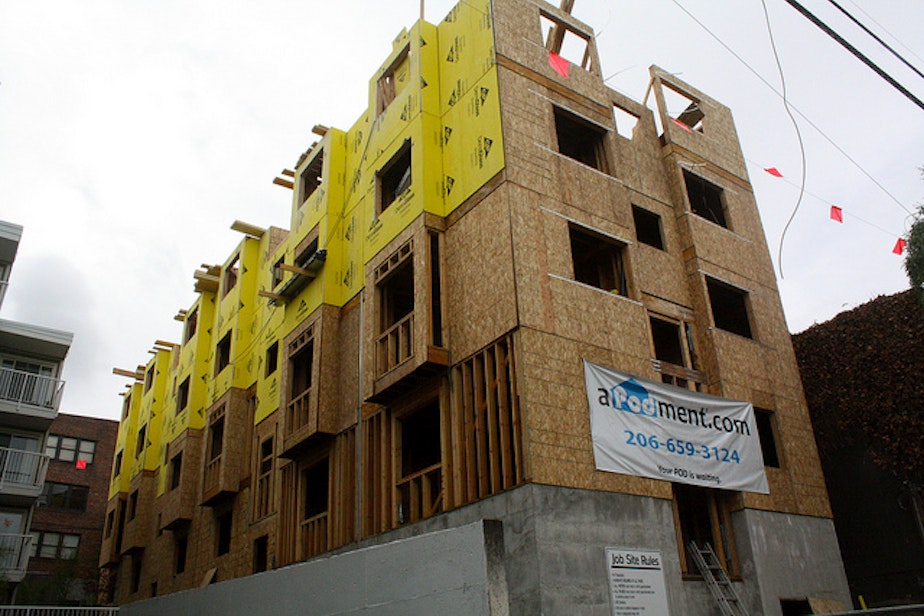Microhousing: Small Spaces Raise Big Questions

Dane Corrida works as a hotel manager for a luxury cruise line based in Seattle. He owns a house on Capitol Hill, but since he spends most of his time working on the boats, he rents it out. If he has a couple of weeks off here and there, he can usually charm a friend or two into letting him couch surf. Late last year, Corrida was given several months off work, so he started trying to find a place to stay. That’s when one of his crew members told him about microhousing. It’s also known by a term trademarked by a real estate developer: apodments.
Corrida checked out some apodments online and found several located in his neighborhood, Capitol Hill. He applied to get a space in a development near Group Health and managed to get the last vacant one. “I was so thankful I got it,” Corrida says.
Corrida apologizes for the mess when he invites us in to check out his space. It’s small – about 200 square feet, a little bit bigger than a standard bedroom. Corrida points out the big window next to his bed, and says, “I have to have that light in my life. Otherwise I feel like I’m living in a shoebox.”
Corrida’s space is private, comes furnished with a bed and desk, and has its own bathroom, sink, microwave and fridge. The only thing missing is a stove, but Corrida has access to several shared kitchens on the property. He pays $775 a month, which includes water, utilities and internet. Also, his lease is month-to-month, so he doesn’t have to worry about paying a penalty for breaking it when he goes back to work. Plus, Corrida says, “it’s cute! It’s new. This building has only been here since June, I think.”
A Possible Loophole
Builder Patrick Tompkins has noticed all the new microhousing developments going up on Capitol Hill too. Tompkins also lives near Group Health in a 1908 home he’s been restoring for the last 14 years. He’s a founding member of the Capitol Hill Coalition, which works on zoning and land use issues. Lately he’s been spending a lot of time trying to figure out why microhousing seems to be going up so fast.
“I think this was the result of developers very carefully reading the land use code and realizing that there was a loophole,” says Tompkins. “They realized that they could come in and build very large structures without having to go through the very tedious process of a design review.”
Seattle’s land use code defines a single dwelling unit in several ways. One factor is the presence of a full kitchen. Generally speaking, in the land use code, one full kitchen equals one single dwelling unit. In the neighborhoods where microhousing is popping up, a development with more than eight kitchens triggers a design review. In Dane Corrida’s microhousing development, there are private rooms for 56 people, but there are only seven or eight shared kitchens. That means no design review, which is a public process involving the city, the developer and the neighbors of the development. That’s where Tompkins sees the loophole in the land use code.
“We’ve kind of skewed the table, so that people who want to come in and build things that are designed more to be a long-term part of the community have a much tougher path to hew,” Tompkins says. “They face the obstacle of maybe having the project held up for a year or a year and a half, in which time they could lose their financing. They could lose all the money they invested in the property; the economy could go bad. I think if you’re going to build large structures like this, then everyone has to play by the same rules.”
It's Been Allowed For Decades
Bryan Stevens doesn’t think there’s a loophole in the land use code. He’s a spokesman for the Seattle Department of Planning and Development, which uses the land use code to guide what gets built and where. He acknowledges that nobody really anticipated microhousing. But, he says, it’s not like microhousing developers are "getting away with something. It’s allowed by the code.”
Stevens points out that the land use code allowing micro-housing has been around for more than thirty years. Historically, the code pertained to housing on Greek Row near the University of Washington and single-family homes with rooms for rent. Microhousing didn’t make an appearance until about three years ago. “We think it’s a valuable housing type, in high demand, obviously,” says Stevens. “It’s a smaller option, but it seems to be a more affordable one that doesn’t necessarily require any sort of subsidy from the city.”
Still, Stevens says the DPD is aware that some neighbors of micro-housing developments are frustrated that there’s no public process before the projects get build. DPD is currently tracking the number of micro-housing developments in Seattle, and looking into whether there needs to be more public involvement before microhousing gets built. And City Councilmember Tom Rasmussen is exploring a possible moratorium on future microhousing developments.
Dane Corrida understands why microhousing has critics. “I get it from their point of view that, yes, you’re throwing another 50 bodies in where four would normally live.” But, he says, “I want to be on the Hill. This is my home. And this was an affordable way for me to be part of the Seattle I love to be around.”

